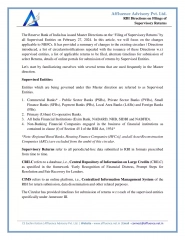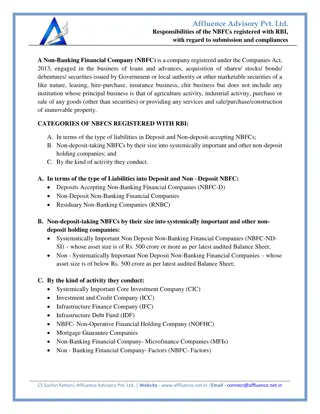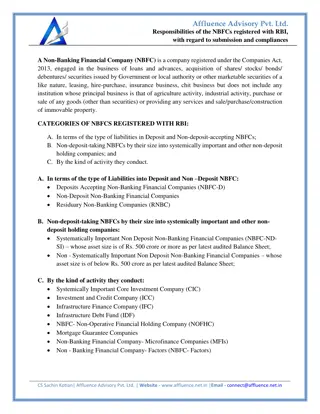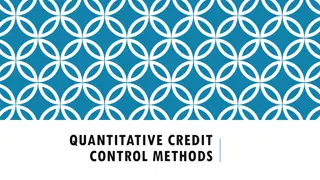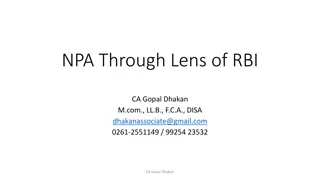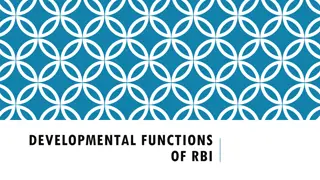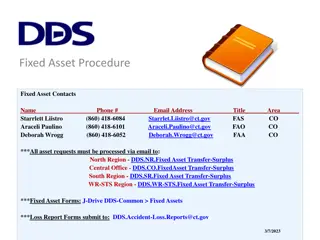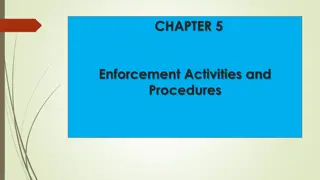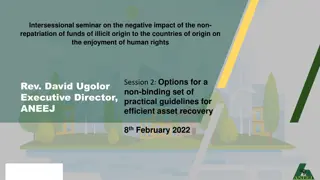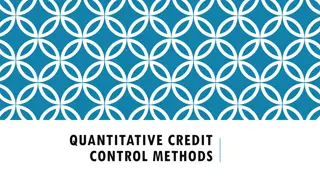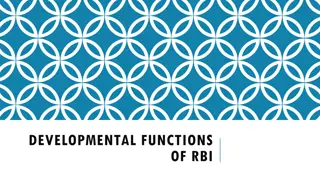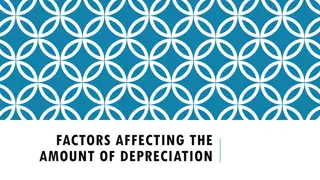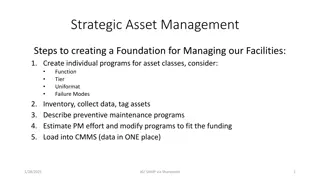Important RBI Circulars and Asset Classification Updates
This content covers important RBI circulars regarding the identification of accounts as NPAs, incipient stress in loan accounts, income recognition, asset classification, and provisioning. It also discusses the significance of deposits, advances, and NPAs in banking. The content emphasizes the ongoing identification of assets as NPAs and the implementation of system-based asset classification by UCBs.
Download Presentation

Please find below an Image/Link to download the presentation.
The content on the website is provided AS IS for your information and personal use only. It may not be sold, licensed, or shared on other websites without obtaining consent from the author.If you encounter any issues during the download, it is possible that the publisher has removed the file from their server.
You are allowed to download the files provided on this website for personal or commercial use, subject to the condition that they are used lawfully. All files are the property of their respective owners.
The content on the website is provided AS IS for your information and personal use only. It may not be sold, licensed, or shared on other websites without obtaining consent from the author.
E N D
Presentation Transcript
BY CA AASHISH BADGE PARTNER RODI DABIR AND CO. MOB 9822567490 EMAIL : aashish@rodidabir.com
Important RBI circulars Identification of accounts as NPA Exceptions / Clarifications Incipient Stress in Loan accounts Income Recognition Asset Classification and Provisioning Projects Under Implementation Upgradation/ subsequent recoveries/ Greening Issues Points to ponder Case Studies CAAashish Badge 2
Deposits make the banking POSSIBLE Advances make the banking PROFITABLE NPAs make the banking PERISHABLE CA AASHISH BADGE. 3
Date 08/05/2023 Date Circular Master Circular Classification ,Provisioning and other Related Matters UCBs Circular Master Circular - - Income Recognition, Asset Classification ,Provisioning and other Related Matters- - UCBs Income Recognition, Asset CA AASHISH BADGE. 4
Para 2.1.4 : Identification of Assets as NPAs should be done on an ongoing basis (i) The system should ensure that identification of NPAs is done on an on-going basis and accounts are classified as NPA immediately, as soon as they turn into NPA without waiting till the end of quarter/financial year. Banks should also make provisions for NPAs as at the end of each calendar quarter i.e. as at the end of March / June / September / December, so that the income and expenditure account for the respective quarters as well as the P&L account and balance sheet for the year end reflects the provision made for NPAs. (ii) The borrower accounts shall be flagged as overdue by banks as part of their day-end processes for the due date, irrespective of the time of running such processes. Similarly, classification of borrower accounts as SMA3as well as NPA shall be done as part of day-end process for the relevant date the SMA or NPA classification date shall be the calendar date for which the day end process is run. the date of SMA/NPA shall reflect the asset classification status of an account at the day-end of that calendar date. CA AASHISH BADGE. 5
UCBs having total assets of 2000 crore or above as on March 31, 2020 were required to implement system-based asset classification4with effect from June 30, 2021. UCBs having total assets of 1000 crore or above but less than 2000 crore as on March 31, 2020 and having self-assessed themselves as being under Level III or Level IV in terms of the circular DoS.CO/CSITE/BC.4083/31.01.052/2019- 20 dated December 31, 2019 on Comprehensive Cyber Security Framework for UCBs were required to implement system-based asset classification with effect from September 30, 2021. UCBs which meet the above criteria as at the end of the financial year 2020- 2021 or subsequent financial years shall implement system-based asset classification within a period of six months from the end of the financial year concerned. UCBs not meeting the above criteria are also encouraged to voluntarily implement the system-based asset classification in their own interest. CA AASHISH BADGE. 6
Para 2.1.2 (A) : Specification of Due Date/ Repayment Date : The Exact due date for repayment of loan, frequency of repayment , break up between principal and interest, examples of SMA / NPA classification dates, etc. should be clearly specified in the loan agreement. In case of loan facilities with moratorium, the exact date of commencement of repayment shall also be specified in the loan agreements. CA AASHISH BADGE. 7
(iii) Primary (Urban) Co-operative Banks (UCBs) having total assets of 500 crore and above shall report credit information, including classification of an account as Special Mention Account (SMA), on all borrowers having aggregate exposures of 5 crore and above with them to Central Repository of Information on Large Credits (CRILC) maintained by the Reserve Bank. Aggregate exposure shall include all fund-based and non-fund based exposure, including investment exposure on the borrower. (iv) UCBs having total assets of 500 crore and above are required to submit CRILC Report on quarterly basis (v) UCBs should take utmost care about data accuracy and integrity while submitting the information /data on large credit to RBI, failing which penal action as per the provisions of the Banking Regulation Act, 1949 may be taken. CA AASHISH BADGE. 8
Para 2.1.1 NPA: An asset, including a leased asset, becomes non performing when it ceases to generate income for the bank Overdue: Any amount due to the bank under any credit facility is overdue if it is not paid on the due date fixed by the bank. Para 2.1.4 Borrower account should be flagged as overdue by banks as a part of their day end processes CA AASHISH BADGE. 9
1. If the outstanding balance remains continuously in excess of the sanctioned limit/drawing power for 90 days. 2. In cases where the outstanding balance in the principal operating account is less than the sanctioned limit/drawing power, but there are no credits continuously for 90 days or 3. Credits are not enough to cover the interest debited during the previous 90 days period. The aforesaid previous 90 days period is inclusive of the day for which the day-end process is being run. CA AASHISH BADGE. 10
Definition of out of Order shall be applicable to all loan products being offered as an Overdraft Facility including those not meant for business purpose and/or which entail interest repayments as the only credits. CA AASHISH BADGE. 11
Term Loan: interest and/ or instalment of principal remains overdue for a period of more than 90 days CC/OD: Account remains Out of Order as per para 2.2 discussed above Bills: Bill remains overdue for a period of more than 90 days (v) Any amount to be received remains overdue for a period of more than 90 days in respect of other accounts. Bank Guarantee: In case Bank Guarantee is invoked and the amount remains unpaid CA AASHISH BADGE. 12
Letter of Credit: In case Letter of Credit is devolved and the amount remains unpaid Short duration crops: Instalment of principal or interest thereon remains overdue for two crop seasons Long duration crops: Instalment of principal or interest thereon remains overdue for one crop season Farm Credit ??? ucb CA AASHISH BADGE. 13
Para 2.1.2 (B) Credit Card Dues : Minimum amount due is not paid within 90 days from the payment due date mentioned in the statement. CA AASHISH BADGE. 14
Para 2.1.1 (vi) In addition, an account may also be classified as NPA in terms of certain specific provisions of this Master Circular, including inter alia paragraphs 2.2.7 and clarifications provided under the frequently asked questions (FAQs) in Annex-4. CA AASHISH BADGE. 15
Advances against Term Deposit, NSCs, KVPs, & Life Policies need not be treated as NPAs, provided adequate margin is available. The credit facilities backed by guarantee of the Central Government through overdue may be treated as NPA only when the Government repudiates its guarantee when invoked.(Income to be recognised only on cash basis) State Government guaranteed advances would attract asset classification and provisioning norms if interest and/or any other amount due to the bank remains overdue for more than 90 days. CA AASHISH BADGE. 16
Annexure 4 Working Capital Accounts: Drawing power calculated from stock statements older than three months, would be deemed as irregular Account will become NPA if such irregular drawings are permitted in the account for a continuous period of 90 days An account where the regular/ad hoc credit limits have not been reviewed/renewed within 180 days from the due date/date of ad hoc sanction will be treated as NPA CA AASHISH BADGE. 17
Outstanding Balance in account based on the drawing power calculated from stock statements older than 3 months would be deemed as irregular & if such irregular drawing are permitted for a period of 90 days, account needs to be classified as NPA. In case of consortium accounts, the drawing power calculation and allocation is made by the Lead Bank and is binding on the Member Banks (circular no. No. C&I/Circular/2014-15/689 dated 29 September 2014 issued by the Indian Banks Association). Non-renewal/ Non-regularization of regular / adhoc limit within 180 days from the due date CA AASHISH BADGE. 18
Solitary or few credit entries recorded before Balance Sheet to regularize the account. Whether the account is having inherent weakness? Yes Mark the account as NPA No : The bank to evidence the auditors about manner of regularization of account CA AASHISH BADGE. 19
(i)All facilities granted to a borrower shall be treated as NPA & not only that facility which has become irregular. Asset class should be worst amongst asset classes that may ascribed to each facility. (ii)However, in respect of consortium advances or financing under multiple banking arrangements, each bank may classify the borrowal accounts according to its own record of recovery and other aspects having a bearing on the recoverability of the advances. Each bank shall follow the principle at (i) above for NPA classification of a borrower. CA AASHISH BADGE. 20
If realisable value of the security is less than 50% of the value assessed by the bank or accepted by RBI at the time of last inspection. Such NPAs may be straightaway classified under doubtful category. If the realisable value of the security, as assessed by the bank/approved valuer/RBI is less than 10% of the outstanding in the borrowal accounts, straightaway classified as loss asset. asset should be CA AASHISH BADGE. 21
Applicable only if balance in NPA is Rs. 10 Lakhs & above The current assets and their valuation are looked into at the time of Statutory Audit / Concurrent audit. Annual Stock Audit by external agencies in case of larger advances Immovable Properties Valuation should carried out once in three years by approve valuer appointed as per the guidelines approved by the Board of Directors. should be CA AASHISH BADGE. 22
Delay beyond 90 days for submission of stock statements / Financial Statements / Renewal of facility 2. Prevention of conduct of stock audit 3. Reduction of DP by more than 20% post-stock audit 4. Actual sales short of more than 40% as compared to projections 5. Return of more than 3 cheques / overdue bills in span of 30 days 6. Devolvement of LC / BG and its non-payment beyond 30 days 7. Third request for extension of time to create security 8. Increase in frequent overdrafts in Current A/C 9. Borrower reporting stress in business / financials 10. Promoters pledging / selling their shares in the borrower company due to financial stress CA AASHISH BADGE. 23
Substandard Asset: Which has remained NPA for a period less than or equal to 12 months. Doubtful Asset: Which has remained in the substandard category for a period of 12 months. Loss Asset: Where loss has been identified by the bank or internal or external auditors or the RBI inspection but the amount has not been written off wholly. CA AASHISH BADGE. 24
(i) Banks are not permitted to upgrade the classification of any advance in respect of which the terms have been re- negotiated unless the package of re-negotiated terms has worked satisfactorily for a period of one year. the existing credit facilities sanctioned to a unit under rehabilitation packages approved institutions will continue to be classified as sub-standard or doubtful, as the case may be by term lending in respect of additional facilities sanctioned under the rehabilitation packages, the income recognition and asset classification norms will become applicable after a period of one year from the date of disbursement. CA AASHISH BADGE. 25
(ii) A similar relaxation be made in respect of SSI units which are identified as sick by banks themselves and where rehabilitation packages / nursing programmes have been drawn by the banks themselves or arrangements. under consortium CA AASHISH BADGE. 26
(vi) RBI would continue to identify the divergences arising due to non-compliance, accountability. Where compliance by the official responsible for classification and is well documented, RBI would initiate deterrent action including imposition of monetary penalties. for wilful fixing non- there is CA AASHISH BADGE. 27
Sr No. 1 Sr No. Category Category Period Period Provision Requirement 20% Provision Requirement Doubtful 1 Upto One Year after substandard One to Three Years More than Three Years 2 3 Doubtful II Doubtful III 30% 100% CA AASHISH BADGE. 28
If realisable value of the security is less than 50% of the value assessed by the bank or accepted by RBI at the time of last inspection. Such NPAs may be straightaway classified under doubtful category. If the realisable value of the security, as assessed by the bank/approved valuer/RBI is less than 10% of the outstanding in the borrowal accounts, straightaway classified as loss asset. asset should be CA AASHISH BADGE. 29
Income from NPA is not recognised on accrual basis but is booked as income only when it is actually received. Banks should adopt an accounting principle for appropriation of recoveries in NPAs and exercise the right of appropriation of recoveries in a uniform and consistent manner. CA AASHISH BADGE. 30
4.1.3 : Fees and commissions earned by the banks as a result of renegotiations or rescheduling of outstanding debts should be recognised on an accrual basis over the period of time covered by the renegotiated or rescheduled extension of credit. 4.1.5 In cases of loans where moratorium has been granted for repayment of interest, income may be recognisd on accrual basis for accounts which continue to be classified as standard . This shall be evaluated against the definition of restructuring provided in paragraph 16 of this Master Circular. CA AASHISH BADGE. 31
4.2.1 If any advance, including bills purchased and discounted, becomes NPA, the entire interest accrued and credited to income account in the past periods, should be reversed if the same is not realised. This will apply to Government guaranteed accounts also. 4.2.2 If loans with moratorium on payment of interest (permitted at the time of sanction of the loan) become NPA after the moratorium period is over, the capitalized interest, if any, corresponding to the interest accrued during such moratorium period need not be reversed. 4.2.3 In respect of NPAs, fees, commission and similar income that have accrued should cease to accrue in the current period and should be reversed with respect to past periods, if uncollected. 4.2.4 Leased Assets - The finance charge component of finance income [as defined in AS 19 Leases )] on the leased asset which has accrued and was credited to income account before the asset became non-performing, and remaining unrealised, should be reversed or provided for in the current accounting period. CA AASHISH BADGE. 32
Where entire overdues pertaining to all the credit facilities availed by a borrower from a given bank have been regularised by repayment through genuine sources (not by sanction of additional facilities or transfer of funds between accounts), the accounts may be upgraded to standard asset category. In such cases, it should, however, be ensured that the accounts remain in order subsequently and a solitary credit entry made in an account on or before the balance sheet date which extinguishes the overdue amount of interest or installment of principal is not reckoned as the sole criteria for treatment of the account as a standard asset. Partial recovery of overdues will not amount to upgradation CA AASHISH BADGE. 33
Loss Assets: 100% of the outstanding Doubtful Assets: Period Provision Requirement (%) Secured Portion 20 30 100 Unsecured Portion 100 100 100 Up to one year One to three years > three years CA AASHISH BADGE. 34
Sub-Standard Assets: 1) A general provision of 10% has to be made on the total outstanding of the substandard asset without making any allowance for ECGC cover and security available. CA AASHISH BADGE. 35
Standard Assets: Direct advances to agricultural and SME sectors (Micro & Small) - 0.25 % Advances to Commercial Real Estate (CRE) 1.00% Advances to Commercial Real Estate Residential Housing Sector (CRE-RH) 0.75% All other loans and advances not included in (1) and (2) above - 0.40% CA AASHISH BADGE. 36
The erstwhile Tier I UCBs, which are currently maintaining standard asset provision of 0.25% on all other loans and advances not included above are permitted to achieve the provisioning requirement of 0.40% on such advances in a staggered manner by March 31, 2025. Thus, provision on all such standard loans and advances outstanding as on March 31, 2023 shall be increased to 0.30% by March 31, 2024, to 0.35% by September 30, 2024 and to 0.40% by March 31, 2025. The provisions towards "standard assets" need not be netted from gross advances but shown separately as "Contingent Provision against Standard Assets" under "Other Funds and Reserves" {item.2 (viii) of Capital and Liabilities} in the Balance Sheet. CA AASHISH BADGE. 37
In case banks are already maintaining excess provision than what is required / prescribed by Statutory Auditor / RBI Inspection for impaired credits under Bad and Doubtful Debt Reserve, additional provision required for Standard Assets may be segregated from Bad and Doubtful Debt Reserve and the same may be parked under the head "Contingent Provisions against Standard Assets" with the approval of their Board of Directors. Shortfall if any, on this account may be made good in the normal course. The above contingent provision will be eligible for inclusion in Tier II capital. CA AASHISH BADGE. 38
Provisioning Coverage Ratio (PCR) is the ratio of provisioning to gross NPA. It indicates the extent of funds a bank has kept aside to cover loan losses. CA AASHISH BADGE. 39
A restructured account is one where the bank, for economic or legal reasons relating to the borrower s financial difficulty, grants concessions that the bank would not otherwise consider. to the borrower Restructuring would normally involve modification of terms of the advances/securities, which would generally include, among others, alteration of repayment period/repayable amount/the amount of instalments/rate of interest. CA AASHISH BADGE. 40
Project loan means any term loan which has been extended for the purpose of setting up of an economic venture. The bank needs to clearly spell out Date of Completion (DC) and Date of Commencement of Commercial Operations (DCCO) at the time of sanction. Type of Project Loan: 1.Infrastructure Sector 2.Non-Infrastructure Sector CA AASHISH BADGE. 41
There may be occasions when completion of projects is delayed for legal and other extraneous reasons like delays in Government approvals etc. All these factors, which are beyond the control of the promoters, may lead to delay in project implementation and involve restructuring / rescheduling of loans by banks. If a project loan classified as 'standard asset' is restructured any time during the period up to two years from the original date of commencement of commercial operations (DCCO), in accordance with prudential guidelines on restructuring of advances at paragraph 2.2.7 above, it can be retained as a standard asset if the fresh DCCO is fixed within the following limits, and further provided the account continues to be serviced as per the restructured terms: CA AASHISH BADGE. 42
Deferment of DCCO If schedule is for equal or shorter duration, then the account is considered as restructuring but treated as standard asset if: Particulars Infrastructure Revised DCCO is within original DCCO deferment and consequential shift in repayment Non-Infrastructure One year from original DCCO Two years from Revision due to Court Case 2 + 2 Years from original DCCO 1 + 1 Years from original DCCO Revision due to any other reason beyond the control of promoters 2 + 1 Years from original DCCO CA Aashish Badge 41
Deferment of DCCO & Retention of Class Conditions 1. Benefit of asset classification not applicable to CRE with extension by 1 year as per circular dated 07.02.2020 2. Application for restructuring (deferment of DCCO) is received upto two years from date of original DCCO for Infrastructure and six months w.r.t. non-infrastructure 3. Account needs to be standard 4. If moratorium given for interest, income on accrual can be booked till two years from date of original DCCO for Infrastructure and six months w.r.t. non-infrastructure 5. Until two years from the original DCCO During the third and the fourth years after the original DCCO. 0.40% 1.00% 42 CA Aashish Badge
Additional Projects to be maintained : Until two years from the original DCCO During the third and the fourth years after the original DCCO. provision for Infrastructure 0.40% 1.00% Additional Provision for Non Infrastructure Projects to be maintained : Until the first six months from the original DCCO During the next six months 0.40% 1.00% CA AASHISH BADGE. 45
i) The increase in scope and size of the project takes place before commencement of commercial operations of the existing project. ii) The rise in cost excluding any cost-overrun in respect of the original project is 25% or more of the original outlay. iii) The bank re-assesses the viability of the project before approving the enhancement of scope and fixing a fresh DCCP. iv) On re-rating, (if already rated) the new rating is not below the previous rating by more than one notch. CA AASHISH BADGE. 46
Fully closed accounts. AS-5 Events occurring after the Balance Sheet date. Source of recoveries. Recovery of all arrears. Best judgment of the auditor based on the full knowledge of the account. No window dressing or ever greening of the account. RBI inspection post our audit. CA Aashish Badge 4 7
Sanction/extension of Additional facility/Adhoc facility. Enhancement of Limit. Conversion of Overdue Limits. Interchangeability of Fund and Non-Fund based Frequent Reschedulement of Term Loans. Adjusting Loan of one borrower against another Borrower. Debiting Suspense and crediting Borrower. Purchasing Cheques from Party. CA Aashish Badge 4 8
Divergences in NPAobserved by RBIAFI Verification Parameters in CBS vis- -vis RBI Circular Purity of Master Data in CBS Reversal of un-serviced Interest of NPA Availability of valuation of security for advances below 5 crores Authenticity and regularity of stock statements Date of NPA current and prior year of newly identified NPAs Unique Customer-id of borrower accounts Accounts upgraded during the year-whether all arrears recovered Regularisation of account subsequent to balance sheet date CA Aashish Badge 49
Points to Ponder Accounts other than Advances accounts including Sundries / SuspenseAccounts Accounts transferred to other branches control over identification / classification of accounts Income leakages identified and resulting in overdrawing of accounts LCs and BGs o/s in case of NPAaccounts Recalculation of Drawing Power Early Mortality Cases Ever-greening of accounts MOCs vis- -vis MainAudit Report vis- -vis LFAR no contradiction CA Aashish Badge 50


